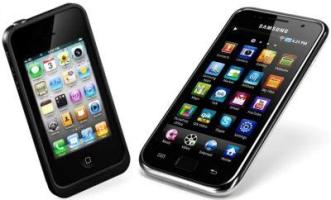Apple: Samsung Copied iPhone Application Icons

In Apple’s $2.5bn patent lawsuit against Samsung, the iPhone maker brought in a graphic designer to testify that Samsung copied the design of the smartphone’s icons
In an effort to make its patent case against Samsung as strong as possible, Apple brought forth a graphic designer as a witness to claim Samsung copied the look of Apple application icons in the design of its smartphones and tablets.
The icons on a Samsung phone that identify applications such as e-mail, messaging, contacts and other programs are “substantially similar” to those patented designs on an iPhone, said Susan Kare, a graphic design expert and former Apple employee.
‘Confusingly similar’
Kare testified on 7 August during the continuation of Apple’s $2.5 billion (£1.6bn) patent infringement suit against Samsung going on in US District Court in San Jose, California. Apple accuses Samsung of infringing on multiple patents on the iPhone and iPad products by copying many of its design features in Samsung’s products.
 Under questioning by Apple attorney Rachel Krevans, Kare looked at 11 different Samsung smartphones with model names such as the Captivate, Continuum, Droid Charge, Epic 4G and Galaxy S 4G and declared that their icon designs make “substantially the same… visual impression” as the iPhone’s.
Under questioning by Apple attorney Rachel Krevans, Kare looked at 11 different Samsung smartphones with model names such as the Captivate, Continuum, Droid Charge, Epic 4G and Galaxy S 4G and declared that their icon designs make “substantially the same… visual impression” as the iPhone’s.
She added a short time later that they were “confusingly similar” to the look of the iPhone.
Kare’s testimony mirrors that of other Apple witnesses at the trial, who supported the company’s argument that Samsung’s copies of iPhone product designs create confusion in consumers’ minds about which phone is which.
It was a point made earlier in the trial by Philip Schiller, the senior vice president of worldwide marketing at Apple, who testified that Samsung “has ripped off a number of our design elements” and that the copying has caused confusion for consumers.
This report is based on information from a live blog of the trial proceedings posted on the website of the San Jose Mercury News.
Under cross-examination by Samsung lawyer Charles Verhoeven, Kare was asked whether once consumers turned on a phone that they were thinking of buying whether they wouldn’t see the Samsung or Apple logos and easily figure out what brand of phone they were holding. Kare answered that she wasn’t a consumer expert and considered the question outside her area of expertise.
Distinctive ‘trade dress’
Apple next called Russell Winer, a marketing expert, author and educator, who was brought in to testify as to the distinctiveness of Apple’s “trade dress”. Trade dress is a legal term in intellectual property law that refers to the overall distinctiveness or iconic nature of the design of a product, a logo or even a building. Examples could include the golden arches of a McDonald’s restaurant, the “double-kidney” shaped grille of a BMW or, in this case, the design of an iPhone.
“I think Apple’s trade dresses are among the most distinctive in the world,” Winer told the jury.
Winer referred to a Samsung document entered into evidence that praised the iPhone because it “sets the standard for screen centric design”. Winer calls that comment proof that Samsung viewed the iPhone as a “target product” for its smartphone development.
But a Samsung attorney asserted that Winer had no hard evidence that Apple has suffered a loss of sales or market share by Samsung’s products supposedly being confused with Apple’s.
According to the latest figures from IDC, the Apple iPad commanded 68.2 percent of the worldwide tablet market in the second quarter of 2012, followed by Samsung’s 9.6 percent share. As for smartphones, IDC reported that Samsung enjoyed a 32.6 percent global market share in the second quarter to Apple’s second place share of 16.9 percent.
Are you a Firefox enthusiast? Take our quiz.